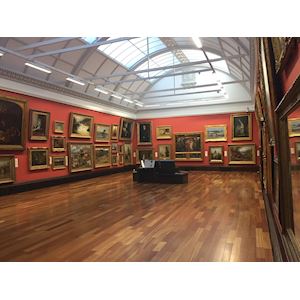
13. VICTORIA GALLERY
You’re now in the Victoria Gallery. As you can see, Dundee has an important fine art collection. James Holloway, the former Director of the Scottish National Portrait Gallery has said: “Dundee has the best collection of Victorian Scottish Painting that can be seen anywhere.” The Gallery looks just as it did when it opened in 1889. You’ve probably noticed that paintings are hung high on the wall. This was the approach used in the Victorian era. The unique curved walls enable the higher paintings to be tipped forward towards you, making it easier to see them. As you explore this gallery, you’ll see that a nationally important collection of Scottish oil paintings is shown alongside works by major English artists. The gallery is hung in three distinct groups, clockwise from the left: The first group is Scottish paintings created between 1750 and 1850. During the eighteenth century, Scotland was at the forefront of intellectual thought in Europe. The philosophers of the Scottish Enlightenment used reason to make sense of the world. In painting, this was reflected in the adoption of the classical style. Notice how the compositions of the paintings in this group are harmonious and balanced with idealized figures. These are features of the classical style. The second group is Victorian Paintings that were created between 1850 and 1900. Victorian artists loved paintings that tell a story, and often illustrated scenes from popular novels. Victorian artists, influenced by the Romantic Movement, were inspired to create heroic depictions of Scotland's history, including scenes from Scotland’s Jacobite past. You’ll also see a number of landscapes, rural scenes, and seascapes in this display. As more and more Scots moved from the country to the city, there was a new interest in compositions that focused on natural beauty. The third group of paintings in this gallery were created between 1890 and 1920, during the Edwardian period. These include works by a group called The Glasgow Boys, who rejected Victorian sentimentality, and focused instead on the realism of everyday subjects. They brought a new sense of light into Scottish painting. The European Symbolist movement inspired many Scottish artists of the 1890s to create works that were influenced by Celtic myth and legend. Look for the five stops in this gallery which enable you to explore selected paintings, from this Recognised collection of national significance, in more detail.


The McManus: Dundee's Art Gallery and Museum
The McManus: Dundee’s Art Gallery and Museum is situated in the centre of Dundee. The Museum and Art Gallery originally known as the Albert Institute was opened in 1867 as a memorial to Prince Albert. In 2005 The McManus closed for a major refurbishment, reopening again on the 28th February 2010. We celebrated our 150th Anniversay in 2017 with a year of celebration. In 2020 we were awarded Visitor Attraction of the Year by Visit Scotland. The McManus has 8 galleries, which are laid out on 2 floors. Visitors can embark on a journey through 400 million years, and witness how a small settlement developed into the City of Dundee as it is today. From exhibits relating to the life of early man in the area, stunning paintings and decorative art through to artefacts from industries past and present, the City's collections, many of which are recognised as being of national significance, give an insight into Dundee and its people.
- The McManus: Dundee's Art Gallery and Museum
- Dundee United Kingdom
- www.mcmanus.co.uk
